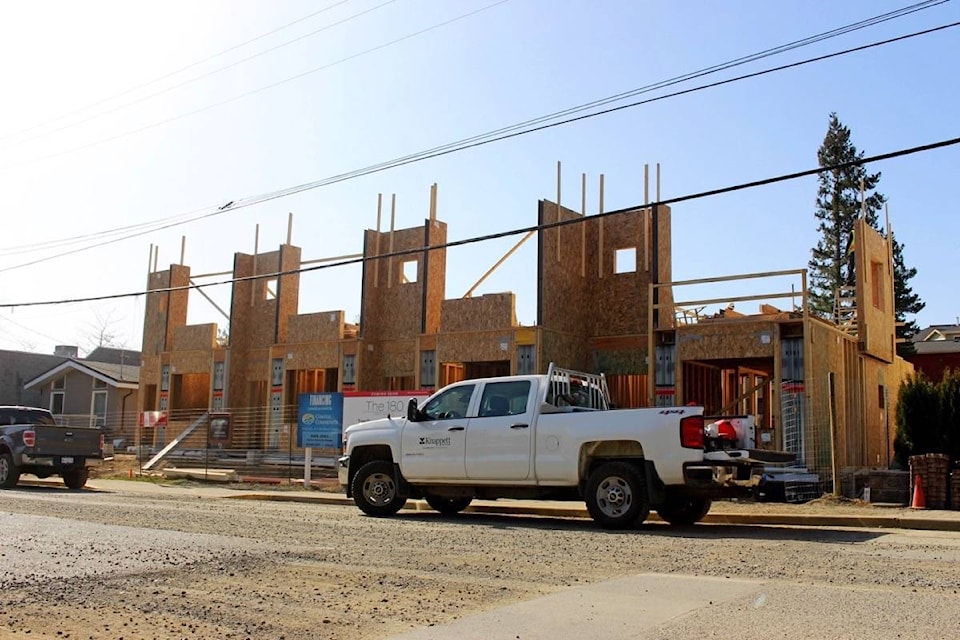As of February, 2018, the Town of Qualicum Beach has 90 vacant lots remaining to build on.
Last month, the town released a quick facts sheet on land supply and residential growth within the town. The document includes six question-and-answer portions with questions such as “How much construction activity has been taking place?” and “How much growth can be accommodated within the land use policies of the Official Community Plan?”
The fact sheet compiled information from the Town of Qualicum Beach, BC Assessment and the 2011 and 2016 censuses.
The count of 90 remaining vacant lots, town planning director Luke Sales said, is based on BC Assessment data, and doesn’t include the option of subdividing the lots — which could be a possibility.
“In their statistics, it’s just one big empty lot,” he said.
From November, 2014 to February, 2018, the town has issued building permits for 124 single-family dwellings and 151 multi-family dwelling units. However, of the 151 units, 94 units are in the Berwick Retirement Communities facility, which is currently being built.
In the last three years, 40 single-family residential or duplex building lots in two developments have been approved but not yet subdivided; 41 multi-family dwelling units in two developments have been approved but are not yet under construction; and 102 multi-family units are under construction in two projects.
Two other developments are still in the approval process.
But some of those development permits, Sales said, might not be for previously vacant lots. He said over the same time period, November, 2014 to February, 2018, the town averaged about five residential demolitions each year, adding that there was a higher number of demolitions last year than in previous years.
According to the 2016 Statistics Canada Census, the town’s population increased by 2.9 per cent between 2011 and 2016. The town document states that the town population grew about 50 people per year. Sales said population growth is very speculative, especially over long periods of time.
“There’s a lot of factors when you’re talking about population growth. That’s one of the reasons that it’s often better to talk about dwelling units because we’ve seen in Qualicum Beach that the average household size has gone down.”
Statistics Canada’s 2016 census states the average household size in Qualicum Beach is two people.
Based on land policies in the 2011 Official Community Plan, the town could be expected to reach a population of 12,000 people in the next 50 years which would be an increase of about 3,000 people from the town’s 2016 population of 8,943.
At an April 9 meeting for OCP discussions, Mayor Teunis Westbroek said there are misconceptions about the 12,000 population, adding that some people thought it was a population cap.
“As soon as that number popped up, people thought, ‘Oh, that’s the (population) cap.’ It’s not a cap, it’s just an estimate of how many people we could accommodate,” Westbroek said. “What we decided to do was to look at how many people could be accommodated in Qualicum Beach based on current zoning and boundaries, including ALR boundaries. At that time it was considered roughly 12,000.”
The 12,000 population estimate would see the majority of the population growth through infill development in the village neighbourhood.
However, Coun. Bill Luchtmeijer has constantly stated his frustration with the OCP and how it can sometimes restrict growth and development.
Referring to a proposed development on Rye Road at the April 16 meeting, Luchtmeijer said he found it rather ironic that as a town, council tells developers they can build up to 12 units on a property based on the OCP. He added that the developer came forward with a five-unit proposal and “we (council) chop them down to three.”
“We identified the village neighbourhood as an area where we increased the densities to allow people to live within walking distance of downtown,” Luchtmeijer continued. “We have now taken this large chunk of property and for the next 50-80 years, they’re going to be single-family houses, three of them. There should be 12 under our developed plan.
“The document (the OCP) lies to the public, and I think we need to address that.”
Send story tips: lauren.collins@pqbnews.com
